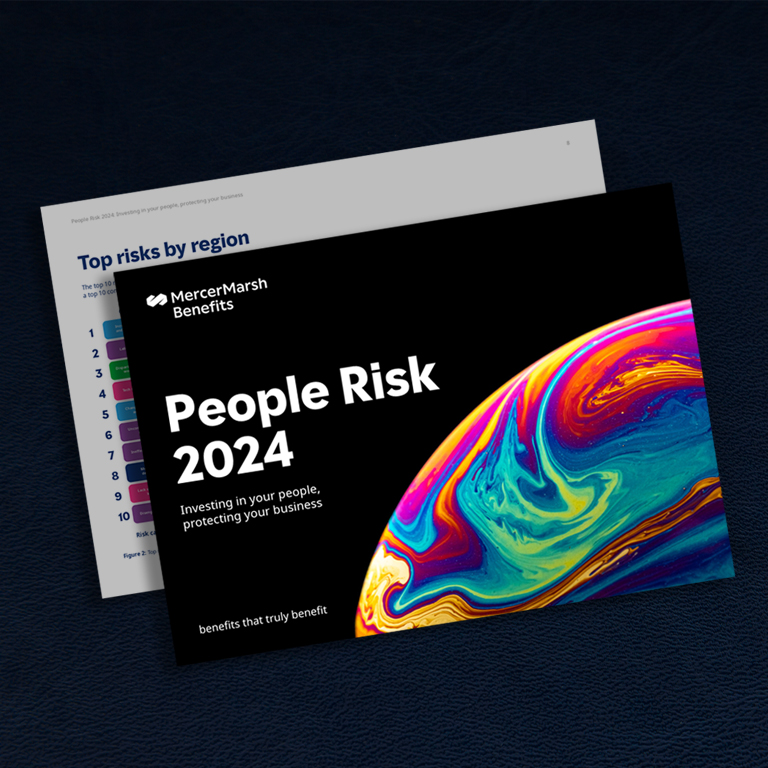
Alison Bamford
Mercer Marsh Benefits Leader
-
New Zealand
Organisations are increasingly feeling the pressure to ensure that profit does not come at the expense of society or the planet. Environmental and social risks featured prominently in the list of top 10 people risks in Pacific, Latin America (LAC), and the Middle East and Africa (MEA). This comes from several quarters, including employees, customers, investors, and regulators.
Employee values have also shifted during the pandemic. Companies now have an opportunity to support attraction and retention goals by demonstrating their commitment to social issues and sustainability.
This is reflected in the People Risk Report. Two environmental and social exposures featured in this year’s top ten global people risks that face businesses: catastrophic personal life events (third) and the environment (eighth).
Despite this, just 77% of HR and risk managers globally feel that their organisations have enough financial resources to manage this category of risk. Firms should urgently address this issue, allocating budget and introducing reward incentives to ensure social risks are tackled at every level of their organisations.
We were surprised to see diversity, equity, and inclusion (DEI) only featuring in the middle of the pack this year. And while it did make it into the top 10 in Australia and in select MEA and LAC countries, it ranked in the bottom 50% of risks in other mature markets. We fear that this is a blind spot and are concerned that HR and risk teams see this as “last year’s issue” (something that has been dealt with) or a uniquely North American problem.
Employees, investors, regulators, and customers all expect firms to have well-considered strategies for tackling environmental risks. Many parts of the world are facing climate change events including extreme heat and flooding, clean water scarcity, and severe air pollution. Tackling environmental risks has become a priority and organisations are looking at multiple mitigations, from creating eco-friendly offices, buying from sources with sustainable practices, and shifting to renewable sources of energy. Environmental issues also impact health and safety, and there is a greater emphasis on health and well-being policies that can address climate-related health events; for example, asthma management and needed mental health supports.
However, the research showed that risk and HR managers perceive environmental and social risks as more important to employees and customers than the C-suite and investors. While this could be purely perception, this cynicism may be impacting motivation to effect change.
This year, DEI was ranked just 17th out of 25 risks facing employers—dropping significantly since last year for most regions. This is a huge cause for concern. The reality is that most organisations still have a long way to go when it comes to workplace culture. Visibility and representation are front and center; employers must strive to create benefits policies that represent all their staff. For example, organisations must look at ways to support women in the workplace through flexible work structures, supportive return-to-work programs post-maternity, as well as reskilling and upskilling. There is also a need to increase female representation at the C-suite level, which not only brings diverse opinions to the table but also provides role models for other women.
Women are not the only vulnerable population. For instance, benefits are still largely targeted at the top of the organisational pyramid. With less than 25% of employees globally being confident that they can afford healthcare for their families, more work needs to be done to flip the pyramid and help bridge the affordability and accessibility gap[1]. Many are also concerned about a lack of protection in the event of death, disability, or other personal crisis.
Businesses can consider measures such as contribution reductions and insurance eligibility expansion to tackle this important challenge. On a broader basis, HR and risk managers must evaluate how to put the S in ESG.
There are many areas where employers can play a role with respect to race and ethnic diversity, for example. This includes tackling bias-created health disparities by expanding provider networks to include visible minorities where possible; for example, including photos in provider directories so that it is easier to self-identify with providers.
Firms must engender inclusive return to work, well-being, leave, and flexible options for all workers. Organisations that excel at disability management continuously evolve their claims prevention, early intervention, and vocational/physical rehabilitation to get employees back to work in a human-centered manner so that everybody wins. This is about focusing on abilities instead of disabilities and ensuring workplace barriers are removed.
There is a growing body of research that confirms what many of us suspected—that the pandemic was isolating and further impeded persons with disabilities to access meaningful work. They had access to fewer positions, fewer accommodations and there was a lack of support for assistive technology[2]. Employers seeking to be truly responsible have to consider this lens when designing how, when, and where work is performed.
Other opportunities include environments that allow neurodivergent individuals to contribute using one-on-one or smaller group Zoom sessions, reducing anxiety by sending out the agenda beforehand, using chat tools instead of live discussions to raise and address questions, and allowing employees to provide their meeting contributions in advance[3].
Unions and work councils play a key role in building and supporting inclusivity and disability management programs, and this is a potential area of investment.
For interested organisations, we suggest reviewing the World Economic Forum’s Good Work Framework, which also covers topics such as social justice and skills-driven employability.
Employers should take a holistic approach to addressing social inequities and environmental degradation. We urge employers to continue shaping their benefits to account for environmental and social risks by:
Employees want to feel like they are part of something bigger than themselves. Responsible employers need to recognise that their duty to employees extends well beyond a living wage. Responsible employers must also create workplaces, benefits, and cultures that are inclusive and provide psychological safety within working conditions, as well as employability via a skills development culture and learning programs.
[1] Marsh. Health on Demand. 2021. Available at https://www.marsh.com/ug/services/employee-health-benefits/insights/health-on-demand-2021.html
[2] Jesus, T., Bhattacharjya, S., Papadimitriou, C., Bogdanova, Y., Bentley, J., Arango-Lasprilla, J., & Kamalakannan, S. (2021). Lockdown-Related Disparities Experienced by People with Disabilities during the First Wave of the COVID-19 Pandemic: Scoping Review with Thematic Analysis. International Journal of Environmental Research and Public Health, 18(12), 6178. Available at https://doi.org/10.3390/ijerph18126178
[3] Mellifont, D. Centre for Disability Research and Policy. 2022. COVID-19 related factors affecting the experiences of neurodivergent persons in the workplace: A rapid review. WORK. Available at https://content.iospress.com/articles/work/wor210811

Mercer Marsh Benefits Leader
New Zealand

Report
23/04/2024